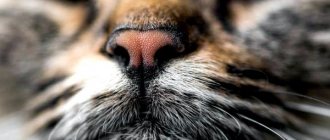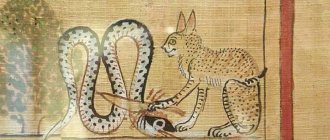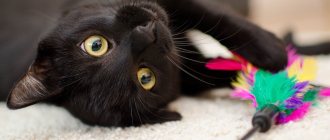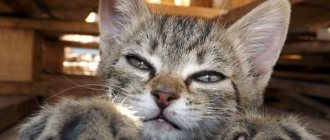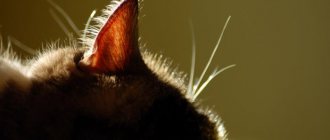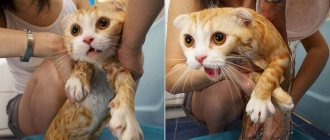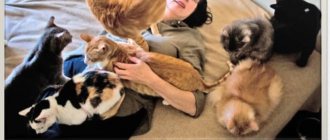https://twizz.ru/wp-content/uploads/2017/05/first-photo-1.jpg
The term “photography” appeared at the beginning of the 19th century, although mention of the camera obscura was recorded in the 4th century BC . In short, photography has a long history, replete with a huge number of “the very first pictures of something,” starting from the very first frame in history, ending with the very first photo on Instagram. It is precisely these images, which have incredible historical significance, that we want to show you today. Enjoy watching!
Cat Day (Cat Day). As noted in different countries. Interesting facts about cats.
Cat Day or Cat Day is an unofficial holiday, but it is celebrated all over the world. The holiday is designed to draw attention to all the merits of these animals to people. On this day, people show love and respect to cats.
Cat Day is celebrated on different dates in different countries. In Russia, it is customary to celebrate March 1 (since 2004, when the Moscow Cat Museum and the editorial office of “Cat and Dog” organized this holiday in Russia for the first time). In most European countries this holiday falls on February 17th. In Japan, Cat Day is celebrated on February 22 (the date was not chosen by chance - why? Read below.). In the USA - October 29 (since 2005, with the support of the ASPCA).
And International Cat Day is August 8th. The initiator of the holiday in 2002 was the International Animal Welfare Foundation. By the way, World Animal Day is October 4th - see HERE
In general, the history of the appearance of the Cat Day holiday is not known, but it is believed that it arose due to the ancient connection between cats and people.
In Great Britain, it is customary to honor the services of cats to the fatherland, because according to statistics, every year one cat saves 10 tons of grain, and the exhibits of the British Museum would have long since fallen into disrepair if they had not been protected from mice by a dozen cats. At one time in the British Museum their number reached 100, later they were sterilized and the number decreased to 6.
Unfortunately, they no longer work in the British Museum, but there are several stuffed animals in the halls. In 1868, three cats were officially employed by the London Remittance Service as mousers. They received a salary of one shilling a week, later 1.5 shillings. Money, as a rule, was spent on their maintenance. During World War II, every British ship carried at least one cat. In the UK, cats still work in some museums and even in the police and receive their salaries.
Cats also become government employees. It is known that the first cats to be officially supported by the state began in 1515. Cats also have an official position - Chief Mouser for the Cabinet of Ministers (at the Prime Minister's residence at 10 Downing Street). True, only four cats had such an official title - Chief Mouser: Humphrey, Sybil, Larry and Freya; others received this title unofficially and were called so by the British press.
Current Chief Mouser - Larry the Cat (since 2011)
World Cat Day in Great Britain is a real holiday, especially for those who serve the state. On this day they are well treated to various delicacies. They offer soft feather beds and a specially tailored uniform - everything to make cats happy and purring.
Austria is keeping up with the UK in celebrating World Cat Day. The most persistent cats and cats who worked in the “civil service” for more than 10 years protecting grain warehouses, etc. receive a pension in the form of meat, broth and milk.
As you know, Russia also has its own “galaxy” of cats who guard museum valuables from rodents in the Hermitage and the Tretyakov Gallery and in other museums. But there are no media reports about rewarding these museum guards on this day. And in the Hermitage budget there is no provision for the maintenance of museum cats, although they honestly fulfill their duties of catching rodents, but live off donations from employees.
“Bulgakov House” the cat Behemoth walks freely around the museum and the surrounding area. It only comes into view when it wants to
As you know, there is an expression “March cat” when cats actively arrange serenades under the windows in the month of March. Laughing, people say that they are happy and announce the coming of spring. After Cat Day was established in Russia on March 1 in 2004, people began to joke that cat serenades had become official: this is how cats congratulate their fellow cats on the holiday.
In China, the celebration of Cat Day is specific. For the sake of this holiday, the Chinese legislated a ban on eating the meat of cats and cats, which certainly became a real holiday for them. (In Asia, about 4 million cats are eaten annually).
In Japan, Cat Day is celebrated on February 22 and this is explained by the fact that in Japanese the meowing of a cat is translated as “nyan-nyan-nyan”. It is believed that "Nyan" means "two", and "two-two-two" is regarded as 22 (February 2). On this day, a Cat Day festival is held in Tokyo, where cats win prizes for the most unique behavior. This holiday has been held since 1987. Then it was first organized by a food production company (based on the results of a survey of residents who have cats).
In Poland, “Cat Day”, like in most European countries, is celebrated on February 17th. A festival is held where people play with cats with balls of wool. The culmination of the holiday is that all the players find themselves wrapped in multi-colored threads from balls of wool.
In Belgium, Cat Day is not an annual holiday, but is held every three years. Then in the city of Ypres, a cat parade is held every second Sunday in May. The holiday was continued from the day “Cat Wednesday”, which was the worst day in the life of cats living in the city of Ypres. On this day - every year in the second week of Lent - the townspeople threw live cats from the bell tower of St. Martin's Church. By the way, in 1955 they decided to resume the tradition of throwing cats, but it was decided to replace the animals with toys.
In Italy, the holiday has its own characteristics and is celebrated on November 17 as Black Cat Day. According to Italian beliefs, this day is the most unlucky day of the year, which is associated with evil spirits and the approaching Halloween. Italians in the Middle Ages firmly believed that a cat with black skin was almost proof and direct evidence of its belonging to witches or the devil, and black cats were exterminated by the Inquisition, considering them to be assistants of the devil.
Therefore, November 17, in Italy, Black Cat Day is considered a day of remembrance of all cats that were subjected to torment and torture in ancient times.
Interesting Facts
Despite all-round love, there are a lot of “stray” and feral cats in the world. Thus, according to experts, there are about 120 million of them (feral cats) in the USA alone. For example, in Chicago there are about 5 million cats. In Australia, the number of stray cats reaches 18 million. According to 2008 data in Estonia, the number of stray cats was twice as high as stray dogs. In Latvia, there is no record of stray cats, but it is believed that in Riga alone there are about 200 thousand of them. And in Belgium, there are practically no stray cats. Strict records are kept, and all domestic cats are microchipped (there are currently 1.84 million cats out of the country's 10.4 million inhabitants).
In Australia, almost 90% of people have cats in their homes. In Australia and Great Britain, a black cat brings good luck.
The world's first professional cat show took place on July 13, 1871 in London, at the Crystal Palace. It was organized by the famous English artist and cat lover Harrison Weir. The public liked the exhibition and soon they began to be held regularly.
Bakeneko
The Japanese believe that after death a cat turns into a spirit. Bakeneko (werecat) is a magical cat in Japanese mythology. The third most popular in Japan (after kitsune (fox werewolf) and tanuki (werewolf raccoon - seen as a positive hero, symbolizing happiness and well-being).
Bakeneko (werecat)
Any cat can become a bakeneko: if it reaches a certain weight = 1 kan (3.75 kg), lives more than 13 years, or has a long tail, which then forks.
Statue of the Egyptian goddess Bast with the head of a cat
There is a Cat Temple in the Japanese city of Kagoshima. It was built not in honor of a sacred cat, but in honor of the ordinary 7 cats that a local commander took with him to war in 1600. Cats served soldiers for hours: the Japanese knew how to tell time by the dilation or contraction of the cat's pupils. Now this temple is mainly of interest to watchmakers.
In Japan, the cat is a symbol of the home.
The cat was one of the many animals that were worshiped in ancient Egypt. She was a symbol of fertility and the sun. The people of Egypt worshiped a goddess with a cat's head.
In ancient Egypt, cats were called Mau.
In Ancient Egypt, smuggling of cats was punishable by death.
Using this belief to defeat the Egyptians, Assyrian warriors tied cats to their shields. The defenders of Egypt could not hit the sacred animal.
In the original Italian version of Cinderella, the good fairy godmother appeared to Cinderella as a cat.
Approximately 95% of people talk to cats.
By meowing, cats try to attract a person's attention. At the same time, the cat can be very persistent and can meow without a break for several hours.
As an expression of love for a person, a cat shows itself by raising its tail upward when near its owner. By the way, wild cats are not able to lift their tail up.
A cat in the house can reduce the risk of a heart attack in the owner. A cat also rubs against a person’s leg in order to mark him as its territory (one might even say as its property).
A cat is able to determine a person’s mood, recognize its owner’s voice, but in most cases ignores it. If a cat lies on its back, it expresses its absolute trust in a person and invites careful caresses.
If a cat does not bury its feces, it means that it is showing aggression towards its owner, making it clear that it is not afraid of anything.
Cats were first seen in Europe in 900 BC.
The cat is an animal that is not on the pages of the Bible (one mention is in the non-canonical “Epistle of Jeremiah”). It is believed that the cat has many “disgusting” habits that are not at all compatible with Christian morality and life. And Jehovah's Witnesses answer the question of why cats are not in the biblical scripture: “Throughout history, especially in the Middle Ages and the Salem witch trials in the early 17th century, cats were recognized as demonically possessed animals, and even actual incarnations of real demons. . Since cats are associated with the Devil, can we, as devoted ordained servants of God, be in any way associated with the “living image” of Satan incarnate?”
In the Middle Ages, on St. John's Day, cats were burned at the stake because they were believed to be involved in black magic. The burning of cats led to an increasing number of rats and other rodent carriers of infections, and with them the emergence of epidemics such as the bubonic plague - which claimed at least 60 million human lives!
Although the Christian Church fought against cats, nevertheless, the first who bequeathed his savings to cats, more precisely 14 cats, was Cardinal Richelieu. In the 17th century, this idea seemed crazy, so as soon as the cardinal died, all the “heirs” were killed.
Nowadays there are many such cat heirs. The richest cat heir was the cat Blackie, who was included in the Guinness Book of Records as the richest cat in the world. It is not known exactly how much the cat got, but the fortune of millionaire Ben Rea was estimated at $25 million at the time of his death. According to the will, the cat should receive “all the best.”
millionaire cat Blackie
According to the Guinness Book of World Records, the richest cats were two cats who inherited $415,000 in the 1960s. And the richest single cat inherited $250,000.
There are many cat museums, but the first one is the one in Germany. Exhibits for the museum were collected by Angelina Ramsperger from all over the world. And now it contains over 3 thousand exhibits. There are 10 cats serving as guards and caretakers in the museum. There is such a museum in Moscow.
Cat Museum in Moscow
The domestic cat Stubs was the honorary mayor of Talkeetna, Alaska, USA. He held his post from 1997 to 2022 (died July 21, 2017 at the age of 20).
Stubs the cat - honorary mayor of Talkeetna
Jack and Donna Wright from Kingston, Ontario are in the Guinness Book of World Records. They have 689 cats.
Excessive love for cats is called Ailurophilia (Ailurophilia or gathophilia, galeophilia is a mental disorder of a person suffering from pathological, uncontrollable attachment and immense love for cats).
Asian leopard cat
The Asian leopard cat, bred by Esmond Gay, is the most expensive cat in the world. Zeus is 90% Bengal and 10% shorthair hybrid and is valued at €100,000.
Maine Coon cat Little Nicky
The most expensive clone cat is the Maine Coon cat Little Nicky. This cat is a clone, born in September 2004 after the death of seventeen-year-old cat Nicky Sr. The owner loved the old cat very much, so she decided to clone. Cloning cost $50,000.
Asherah
The Savannah (Ashera) is considered the most expensive breed of domestic cat. The breed was developed in 1986. The cats reach a maximum weight of 20 kg, with a height at the withers of up to one meter. Maine Coon cats are no less, and sometimes even greater, (translated as “Maine raccoon,” that is, a raccoon from the American state of Maine).
Kira Foster and Maine Coon Rupert
But, while the former (Usher) are best kept in a separate room away from children, Maine Coons are distinguished by an unusually calm, even character and get along well with children and pets, even dogs. Body weight 13-16 kg. The maximum officially registered length of a Maine Coon is 1 m 23 cm.
A cat named Stu holds the record for length among domestic cats - 1.23 m.
And below is the photo of Omar. This red cat lived in Australia. He also has his own page on Instagram - omar_mainecoon
View this post on Instagram
Ever seen a 14kg cat sprint? You have now! You're welcome! . . #omarmainecoon #mainecoon #mainecoonsofinstagram #mainecoongram #gingercats #catsofinstagram
A post shared by Omar the Maine Coon (@omar_mainecoon) on Feb 4, 2019 at 1:07am PST
Cat Omar
The most popular breed is the Persian cat. The most ancient cat breed is considered to be the Mau.
On average, a cat lives 6 years. The most durable cat is considered to be one that was found alive in a destroyed building 80 days after the earthquake in Taiwan in December 1999.
Cat Cream Puff
The cat, Creme Puff, was included in the Guinness Book of Records as the longest-living cat ever recorded (as of 2010). She lived 38 years and 3 days. It was claimed that there was also a cat named Lucy (Great Britain), and that she died in 2015 at the age of 43. However, this was not confirmed and recorded in the Guinness Book of Records.
cat Mr. Peebles
The tiniest cat in the world was the Tinker Toy Himalayan cat from Illinois. He weighed 680 grams, was 18 cm in length, and height (at the withers) 7 cm.
Skif-tay-don
The smallest breed of domestic cat is the Scythian-tay-don (Scythian-toy-bob). They weigh from 900 grams to 2.5 kg, that is, they weigh the same as three to four month old kittens of an ordinary domestic cat.
Cats love enclosed spaces and love to sit in boxes, in which they are found to instinctively hide from predators, gaining restful sleep that can last up to 18 hours a day. Scientists conducted an experiment and it turned out that cats that are allowed to sleep in boxes are less stressed and less aggressive.
Kitty from Staffordshire (UK) gave birth to two kittens at the age of 30! In total she had 218 children. On August 7, 1970, a four-year-old Burmese cat Tarawood Antigone from Oxford (UK) gave birth to 19 kittens. Of these, 14 male kittens and one female cat survived. And the largest litter, with all surviving kittens, was recorded from the Persian cat Bluebell (Bell) in South Africa. She gave birth to 14 kittens.
Towser Cat Monument
Scottish tortoiseshell cat Towser (1966 - 1987), killed 28,899 mice in 21 years. A monument was erected in honor of Towser at the Glenturret Distillery.
Cats are capable of making 100 different sounds. For example, dogs make only 10 types of sounds.
A cat can run at a speed of 48 km/h
A cat is able to drink sea water because its kidneys filter the salt.
A cat has 12 pairs of whiskers, which it needs to move in space.
Tufts of hair in the ears protect the animal from directional sound
All cats are farsighted, so it is difficult for them to see objects that are nearby.
Cats see well in the dark. Due to the position of their eyes, cats can see approximately 300 degrees around them, as each eye has a field of vision ranging from 155 to 208 degrees. A cat's eyes can detect very fast movement (4 mm per second). They do not need to blink to lubricate the surface of the eye. Cats cannot see in complete darkness, but they have many other organs that help them navigate well at night.
About 20 muscles are responsible for the movement of a cat's ears. A cat can turn its ear 180 degrees. During defense, the cat presses its ears to its head. At the moment of attack, the ears move apart.
Kittens, just like small children, have baby teeth. An adult animal has 30 teeth.
Cats do not like sweets because they do not feel the sweet taste, but all cats, without exception, adore valerian. Drinking it makes you stupid.
A cat's nose is unique and has a unique imprint.
It is a misconception that milk is good for cats. Cow's milk is one of the most dangerous allergens for cats. It can cause some health problems for the animal, as many cats are lactose intolerant.
The cat's body temperature is 38 degrees. They prefer to eat foods at room temperature. Ideally, the average food temperature should be 32-40°C.
The cat, with rare exceptions, hates the smell of citrus fruits: tangerines and lemons.
The cat sleeps most of the day, and spends the rest of the time caring for itself - and licking itself
If a cat cannot catch its prey, it begins to clatter its teeth, or “chirp,” which indicates its overwhelming frustration.
A cat's heart beats about 140 beats per minute. For comparison, the human heart beats on average 70-75 beats per minute.
In one minute, the cat makes 30 inhalations and exhalations.
Kittens are able to dream a week after birth. A kitten produces growth hormone only during sleep.
The cat does not sweat, but only the pad of its paw gets wet.
The claws on the front paws are much sharper than the claws on the hind paws
A cat from Ontario, Canada got into the Guinness Book of Records - a five-year-old cat had 27 toes. Typically, a cat has 18 toes (4 on the hind paws and five on the front paws).
Despite their low IQ, cats are capable of solving non-standard problems.
cat Felicette. The cat launch took place on October 18, 1963.
The only cat in the world to have been in space was the cat Felicette from France. She stayed in zero gravity for just over five minutes and experienced g-forces of up to 4g. After landing she was in excellent condition. She also holds the record for the altitude at which cats have been - 155 km. from the earth.
Aspirin (more precisely, acetylsalicylic acid) can be poisonous for a cat, since when it enters the gastrointestinal tract it is metabolized, turning into salicylic acid. Cats do not have enzymes in their bodies to process it. The medicine remains in the stomach for a long time and causes harm to the body.
A cat requires 10 times more territory than a female cat.
A cat's body consists of 517 muscles. The flexibility of a cat's spine is possible due to the presence of 53 vertebrae. The cat skeleton contains 40 more bones than the human skeleton.
A cat is one of the few animals, if not the only one, that can survive a fall from a nine-story building. The cat Andy from Florida (USA) holds a confirmed record for a harmless fall from the highest height - from the 16th floor of a building (approximately 65 meters).
The cat does not know how to climb down from a tree upside down. This is due to the fact that its claws are slightly curved.
A cat sharpens its claws on furniture because it is marking its territory.
When experiencing pleasure, the animal spreads its fingers and retracts its claws.
Cats can sense natural disasters. In the event of an earthquake, the animal leaves the building in advance.
photographer Hiroyuki series of works “Ninja Cats”
A cat can jump to a height 5 times its height.
It is believed that the progenitor of cats is Proailurus, which means “first cat”. Proailurus (lat. Proailurus lemanensis) is an extinct animal of the order of carnivores. Lived in Europe and Asia approximately 25 million years ago, in the late Oligocene and Miocene.
Proailurus (lat. Proailurus lemanensis)
The Turkish Van cat loves to swim. Most domestic cats, to put it mildly, do not like to swim. But they love fresh water and being near water.
Cats love to drink fresh water, so they can often be seen drinking water from the tap. If the owner doesn’t like it, then there is one piece of advice - change the water in the saucer more often.
A domestic cat can survive at temperatures as low as 57 degrees. At the same time, she should have a large amount of water.
Cats are not capable of chewing large pieces of meat. This is because their jaw cannot move laterally.
By bringing mice home, the cat shows that it is not in vain that it eats its bread.
If it is difficult for a cat to make its choice, then it waves its tail in different directions.
The cat licks itself in order to get rid of foreign odors. Cats have a rough tongue that resembles sandpaper. And it’s easier for them to lick their fur.
On 1 square centimeter, cats have 20,155 hairs
As a cat ages, the color of a cat's eyes may change.
And yet... we can write a lot more about our favorites, because this is a truly unique animal.
Kittens
↑ ↑ ↑ Liked this JuicyWorld.org post? Share so you don't lose.
* * * * *
I ask you to support the JuicyWorld.org website with any amount (I will be glad to receive 50 rubles). I will spend everything I receive on the development of the site and new publications. I don’t have enough money of my own - I’m a bedridden invalid. Here >> About me and the site
Support the site >> JuicyWorld.org PayPal.me/mgf67 Sberbank card: 2202200774909236 Sberbank-online (phone number)
* * * * *
Mur-mur-murrrchiki
It’s not for nothing that we call them purrs. On average, cats spend about 10,950 hours purring, and the average speed of sound production is 26 cycles per second. This speed is the same as the operating speed of a diesel engine. Interestingly, purring is produced both when inhaling and exhaling air. This is possible thanks to a set of vocal cords that have adapted to this in the process of evolution.
The record for the loudest purr belongs to Merlin, a black and white cat from the UK. Its purr is 67.8 dB(A), which can be compared to the volume of a shower! Most cats purr at 25 dB.
Well camouflaged!
Cats are sleepyheads
Purrs spend up to 18 hours a day sleeping. This is equivalent to sleeping 70% of your life.
A study conducted by scientists using radio transmitters brought interesting results:
- cats living with people spend 80% of their time resting. Feral 62%;
- domestic cats spend 17% of their time on hygiene, and wild cats 24%;
- Domesticated animals spend 3% on hunting, while wild animals spend up to 14%;
- To walk itself, a domestic cat needs 0.3 square km, and a wild cat needs 5.5 km2.
They don't see it under their noses
They cannot see their nose or what is directly in front of it. Have you noticed? You put a piece of sausage under your nose, but they don’t react. But cats can easily see objects that are at a distance of about 40 meters.
It's harder downhill than uphill
Cats can easily climb tall trees, but they have difficulty descending. The problem is that they have hooked, curved claws. And they are bent only in one direction.

